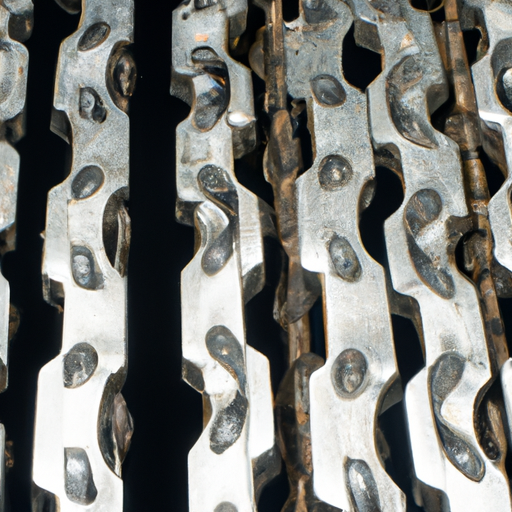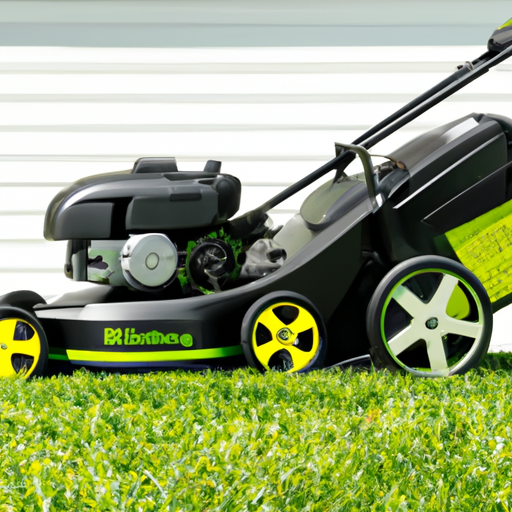If you’re a gardening enthusiast or have trees around your property that need regular maintenance, then understanding the different types of pole saw chains is essential. Whether you’re a novice or an experienced pruner, having the right chain for your pole saw can make all the difference in achieving clean and efficient cuts. From semi-chisel to full-chisel chains, each type has its own unique features and benefits. In this article, we’ll decode the different types of pole saw chains, helping you make an informed decision for your pruning needs. Get ready to elevate your pruning game with the right chain for the job.
1. Pole Saw Chains: An Overview
What are pole saw chains?
A pole saw chain is an essential component of a pole saw, which is a versatile tool used for pruning and trimming trees. The chain is made up of interconnected links that have sharp cutting teeth, allowing them to slice through tree branches with ease.
Why are pole saw chains important in pole saws?
Pole saw chains play a crucial role in the performance and efficiency of pole saws. They determine the cutting ability and durability of the tool. The quality of the chain affects how effectively and quickly you can trim branches. Therefore, understanding the different types of pole saw chains is essential for choosing the right one for your specific needs.
2. Understanding Chain Pitch and Gauge
What is chain pitch?
Chain pitch refers to the distance between the drive links on a chainsaw chain. The pitch determines the size of the chain and how it fits on the guide bar of the pole saw. It is important to match the chain pitch with the guide bar sprocket to ensure proper functioning.
Types of chain pitch
There are usually three common chain pitch sizes: 1/4-inch, 3/8-inch, and 0.325-inch. Each size is suitable for various cutting tasks. Smaller pitch sizes, like 1/4-inch, are ideal for light-duty pruning, while larger pitch sizes, like 3/8-inch, are suitable for heavy-duty tasks.
What is chain gauge?
Chain gauge refers to the thickness of the drive links on a chainsaw chain. It is an important factor in determining the stability and strength of the chain. The chain gauge must match the guide bar groove width for optimal performance.
Types of chain gauge
The two most common chain gauge sizes are 0.050-inch and 0.063-inch. The choice of gauge largely depends on the pole saw model and the cutting requirements. Thicker gauges provide increased durability and stability, making them suitable for demanding tasks.
3. Low-Profile Chains
Features of low-profile chains
Low-profile chains have slender drive links with a reduced profile. They feature small cutting teeth that are designed for light pruning and trimming tasks. These chains are commonly used in residential settings and for occasional tree maintenance.
Benefits of low-profile chains
Low-profile chains offer several advantages. Firstly, their lightweight design allows for easy maneuverability, especially when working at heights with a pole saw. Secondly, these chains require less power so that they are a great fit for low-powered pole saws. Lastly, the smaller chain size ensures smoother cutting and reduced kickback.
Applications of low-profile chains
Low-profile chains are primarily suited for lighter cutting tasks. They are ideal for trimming small branches, shaping shrubs, and general maintenance work around the yard. These chains excel in tasks that require precision and finesse.
4. Full-Profile Chains
Features of full-profile chains
Full-profile chains have larger drive links with a higher profile compared to low-profile chains. They are designed to withstand heavy cutting and demanding applications. They have bigger cutting teeth for more aggressive cutting performance.
Benefits of full-profile chains
Full-profile chains offer increased cutting power and efficiency. Their robust construction allows them to tackle larger branches and more substantial tasks with ease. The larger cutting teeth provide quick and effective cutting, making them ideal for professional arborists and heavy-duty tree maintenance.
Applications of full-profile chains
Full-profile chains excel in heavy-duty applications. They are commonly used in forestry, tree removal, and large-scale landscaping projects. These chains are capable of cutting through thick branches and logs effortlessly, making them the preferred choice for professionals.
5. Semi-Chisel Chains
Features of semi-chisel chains
Semi-chisel chains have a unique design with rounded cutting teeth that alternate with flat cutting links. This design allows for improved cutting performance and reduced kickback. The rounded teeth retain their sharpness for longer durations.
Benefits of semi-chisel chains
Semi-chisel chains offer a great balance between cutting performance and durability. The rounded teeth provide aggressive cutting action, making them suitable for various cutting tasks. Additionally, the design reduces the likelihood of kickback, enhancing user safety.
Applications of semi-chisel chains
Semi-chisel chains are versatile and can be used in a wide range of applications. They are commonly employed for general pruning, landscaping, and yard maintenance tasks. Semi-chisel chains are a popular choice for homeowners and professionals seeking a reliable chain for various cutting needs.
6. Full-Chisel Chains
Features of full-chisel chains
Full-chisel chains have square-cornered cutting teeth that deliver precise and efficient cutting action. They have sharper cutting edges compared to other chains, resulting in faster cutting speed. However, they are also more prone to dulling faster in certain conditions.
Benefits of full-chisel chains
Full-chisel chains are known for their exceptional cutting speed and aggressiveness. They are especially suited for tasks that require quick and efficient cutting, such as tree felling and heavy-duty pruning. These chains are often preferred by seasoned professionals who prioritize speed and performance.
Applications of full-chisel chains
Full-chisel chains are commonly used in the forestry industry, where fast and precise cutting is crucial. They are well-suited for cutting larger limbs, tree trunks, and logs. Due to their high cutting speed, full-chisel chains are not recommended for beginners or those inexperienced with handling pole saws.
7. Micro-Chisel Chains
Features of micro-chisel chains
Micro-chisel chains are a hybrid between semi-chisel and full-chisel chains. They have smaller, rounded-corner teeth that offer improved cutting efficiency while maintaining longer cutting sharpness. This design reduces the risk of kickback and extends the chain’s lifespan.
Benefits of micro-chisel chains
Micro-chisel chains provide excellent cutting performance without sacrificing durability. They are versatile, suitable for both light and heavy-duty cutting tasks. The smaller teeth reduce the chances of kickback, making them safer for users. Additionally, the chain’s extended sharpness means less frequent sharpening or replacement.
Applications of micro-chisel chains
Micro-chisel chains are widely used in professional landscaping, tree care, and residential trimming applications. They are ideal for tasks that require a balance of cutting speed, precision, and durability. Whether you’re shaping hedges or tackling larger branches, micro-chisel chains deliver reliable results.
8. Square-Chisel Chains
Features of square-chisel chains
Square-chisel chains have square-shaped cutting teeth that provide ultimate cutting performance and speed. These chains feature razor-sharp edges and deliver unmatched cutting power, making them suitable for the most demanding cutting tasks.
Benefits of square-chisel chains
Square-chisel chains are known for their incredible cutting speed and efficiency. Their sharp teeth effortlessly sever branches, logs, and trees in a shorter amount of time. These chains are designed for professionals who require the utmost cutting power and performance.
Applications of square-chisel chains
Square-chisel chains are typically used in high-powered, professional-grade pole saws. They are commonly employed in logging operations, large-scale tree removal projects, and other heavy-duty forestry applications. Due to their extreme cutting ability, square-chisel chains should only be used by experienced individuals with proper training.
9. Safety Considerations for Pole Saw Chains
Chain tension and maintenance
Proper chain tension is essential for safe and efficient cutting. Chains that are too loose can jump off the guide bar or cause kickback, while overly tight chains can bind and increase the risk of accidents. Regular maintenance, including sharpening and lubrication, is crucial for optimal chain performance and longevity.
Proper chain lubrication
Applying an adequate amount of chain lubricant is critical for reducing friction and heat buildup. Proper lubrication ensures smooth chain movement and prolongs the life of the chain. Lubrication also helps in preventing rust and corrosion.
Protective gear and precautions
When working with pole saw chains, it is crucial to prioritize safety. Always wear personal protective equipment, such as a helmet, safety glasses, hearing protection, gloves, and chainsaw chaps. Practice proper body mechanics, maintain a secure grip on the pole saw, and be aware of your surroundings to avoid accidents and injuries.
10. Choosing the Right Pole Saw Chain
Identifying your cutting needs
Before selecting a pole saw chain, consider the type of cutting tasks you will be performing. Determine whether you need a chain for light pruning, heavy-duty cutting, or a combination of both. This will help narrow down the options and choose the most suitable chain for your specific requirements.
Considering chain features
Evaluate the features of each chain type, including pitch, gauge, and design. Match these features to your cutting needs. If you require aggressive cutting speed, you may prioritize full-chisel or square-chisel chains. For versatility and balance, micro-chisel or semi-chisel chains may be the best option.
Matching the chain to your pole saw
Ensure that the chain you choose is compatible with your pole saw model. Consider the recommended chain pitch and gauge specified by the manufacturer. Using an incompatible chain can compromise safety, performance, and even damage your pole saw.
Tips for selecting the right pole saw chain
- Research and gather information about the various types of chains available.
- Seek recommendations from professionals or fellow pole saw users.
- Consider the characteristics of the trees or vegetation you will be working with.
- Balance cutting performance, durability, and safety when making your final decision.
- Regularly inspect and maintain your pole saw chain to ensure optimal performance and longevity.
By understanding the different types of pole saw chains and considering your specific needs, you can confidently choose the right chain for your pole saw. Whether you’re a homeowner tackling occasional pruning tasks or a professional arborist working on large-scale projects, having the appropriate chain will enhance your cutting experience and safety. Remember to prioritize safety precautions and proper maintenance to ensure smooth and efficient operation of your pole saw chains for years to come.


